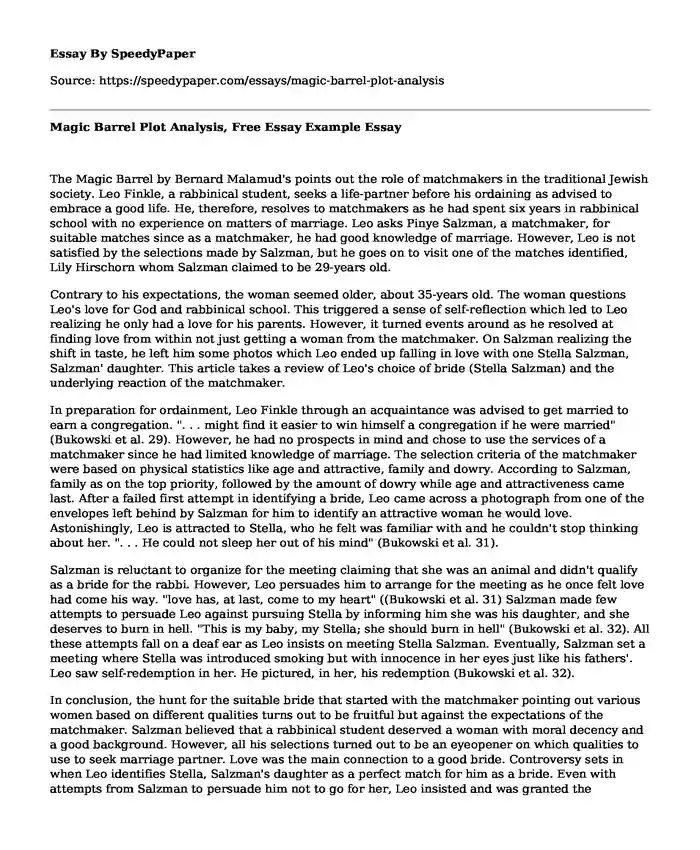
| Type of paper: | Essay |
| Categories: | American literature |
| Pages: | 3 |
| Wordcount: | 676 words |
The Magic Barrel by Bernard Malamud's points out the role of matchmakers in the traditional Jewish society. Leo Finkle, a rabbinical student, seeks a life-partner before his ordaining as advised to embrace a good life. He, therefore, resolves to matchmakers as he had spent six years in rabbinical school with no experience on matters of marriage. Leo asks Pinye Salzman, a matchmaker, for suitable matches since as a matchmaker, he had good knowledge of marriage. However, Leo is not satisfied by the selections made by Salzman, but he goes on to visit one of the matches identified, Lily Hirschorn whom Salzman claimed to be 29-years old.
Contrary to his expectations, the woman seemed older, about 35-years old. The woman questions Leo's love for God and rabbinical school. This triggered a sense of self-reflection which led to Leo realizing he only had a love for his parents. However, it turned events around as he resolved at finding love from within not just getting a woman from the matchmaker. On Salzman realizing the shift in taste, he left him some photos which Leo ended up falling in love with one Stella Salzman, Salzman' daughter. This article takes a review of Leo's choice of bride (Stella Salzman) and the underlying reaction of the matchmaker.
In preparation for ordainment, Leo Finkle through an acquaintance was advised to get married to earn a congregation. ". . . might find it easier to win himself a congregation if he were married" (Bukowski et al. 29). However, he had no prospects in mind and chose to use the services of a matchmaker since he had limited knowledge of marriage. The selection criteria of the matchmaker were based on physical statistics like age and attractive, family and dowry. According to Salzman, family as on the top priority, followed by the amount of dowry while age and attractiveness came last. After a failed first attempt in identifying a bride, Leo came across a photograph from one of the envelopes left behind by Salzman for him to identify an attractive woman he would love. Astonishingly, Leo is attracted to Stella, who he felt was familiar with and he couldn't stop thinking about her. ". . . He could not sleep her out of his mind" (Bukowski et al. 31).
Salzman is reluctant to organize for the meeting claiming that she was an animal and didn't qualify as a bride for the rabbi. However, Leo persuades him to arrange for the meeting as he once felt love had come his way. "love has, at last, come to my heart" ((Bukowski et al. 31) Salzman made few attempts to persuade Leo against pursuing Stella by informing him she was his daughter, and she deserves to burn in hell. "This is my baby, my Stella; she should burn in hell" (Bukowski et al. 32). All these attempts fall on a deaf ear as Leo insists on meeting Stella Salzman. Eventually, Salzman set a meeting where Stella was introduced smoking but with innocence in her eyes just like his fathers'. Leo saw self-redemption in her. He pictured, in her, his redemption (Bukowski et al. 32).
In conclusion, the hunt for the suitable bride that started with the matchmaker pointing out various women based on different qualities turns out to be fruitful but against the expectations of the matchmaker. Salzman believed that a rabbinical student deserved a woman with moral decency and a good background. However, all his selections turned out to be an eyeopener on which qualities to use to seek marriage partner. Love was the main connection to a good bride. Controversy sets in when Leo identifies Stella, Salzman's daughter as a perfect match for him as a bride. Even with attempts from Salzman to persuade him not to go for her, Leo insisted and was granted the opportunity to meet the Stella whom he had fallen in love.
Works cited
Bukowski, Nicholas Howe, and Morris Dickstein. "The Stories of Bernard Malamud: {1958}." A Voice Still Heard: Selected Essays of Irving Howe, edited by Nina Howe, Yale University Press, 2014, pp. 29-32. JSTOR, www.jstor.org/stable/j.ctt1bh4d80.7.
Cite this page
Magic Barrel Plot Analysis, Free Essay Example. (2022, Aug 26). Retrieved from https://speedypaper.com/essays/magic-barrel-plot-analysis
Request Removal
If you are the original author of this essay and no longer wish to have it published on the SpeedyPaper website, please click below to request its removal:
- Toxic Exposure Article Analysis. Essay Example.
- Essay Example: Atomic Bomb in Hiroshima and Nagasaki
- Pre-Columbian Cultures of Olmec and Teotihuacan, Essay Sample
- HRM Essay Example: Layoffs and Downsizing
- Essay Sample Analyzing the Immigration Policies in Texas
- Free Essay Sample on Guilt and Innocence in Atonement
- Essay Sample on Defendant Closing Argument
Popular categories




